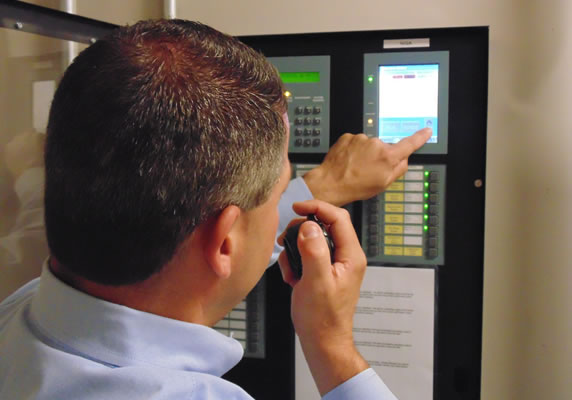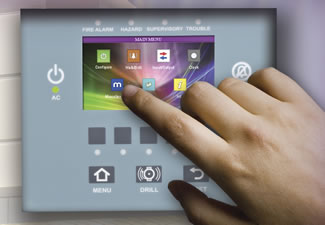 The first time an end user – a facility manager, security guard or building owner – is faced with operating a fire alarm control panel might easily be in an emergency situation. In the midst of such a crisis, it is not the best time to determine which of 20 or 30 different buttons to push. Overly complex fire alarm interfaces make users vulnerable to “floating finger syndrome” – their finger pauses in the air unsure which button to push, paralyzed by fear of selecting the wrong button with no guidance and no intuitive choices.
The first time an end user – a facility manager, security guard or building owner – is faced with operating a fire alarm control panel might easily be in an emergency situation. In the midst of such a crisis, it is not the best time to determine which of 20 or 30 different buttons to push. Overly complex fire alarm interfaces make users vulnerable to “floating finger syndrome” – their finger pauses in the air unsure which button to push, paralyzed by fear of selecting the wrong button with no guidance and no intuitive choices.
In a time of high stress, the need to interface with complex fire alarm systems can undermine a user’s confidence and work against a rapid reaction critical to timely emergency response. The significance of a fast response is magnified when faced with the possible evacuation of a high-rise building.
Usability Observations
The problem becomes especially obvious when observing end users’ reactions when tasked with operating a fire alarm control panel. Most people trained to use a panel have a hard time recalling what they learned during training more than a few years ago. More often than not, the trained individual is not in the vicinity when an emergency occurs, and those who remain are baffled by the complexity of the fire alarm panel.
Putting untrained individuals in front of a fire alarm panel can bring out their “fear of the fire alarm.” After all, everyone is conditioned not to touch a fire alarm system. Observing how they use fire equipment can provide insights into the challenges of designing an easy-to-use, intuitive fire alarm panel interface.
Many end users admit they haven’t touched the fire alarm system in five years or more. But what happens if he or she is the only person around in an emergency? Security personnel, who are responsible for the safety of a building, may be shocked to learn how unprepared their people are in case of an emergency. A lag in response could have a precious cost in terms of time, lives and property.
 An overarching and crippling, concern is: What might happen if I push the wrong button? One factor in the more complex interfaces is the emergence of fire alarm systems that offer additional features and functionality, each controlled by a different series of buttons.
An overarching and crippling, concern is: What might happen if I push the wrong button? One factor in the more complex interfaces is the emergence of fire alarm systems that offer additional features and functionality, each controlled by a different series of buttons.
Human Factors and Touch Screens
Today’s solution is to incorporate more human factors into fire alarm control panel design, including a more intuitive, touch-screen display. However, the fire alarm manufacturing industry has been slow to adopt new touch-screen technology, stalled by codes and standards that can stifle innovation. Touch screens have also emerged more rapidly on higher-end systems, although smaller and mid-market systems have just as much need for them - and just as much at stake.
In an emergency situation, the end user typically needs to know several key pieces of information:
- Where is the alarm?
- What type of device is involved?
- Who do I call?
- How do I silence the buzzer?
They want to deal with the fire alarm panel and then move on to making other emergency decisions. Holding simulated emergency events can help end users pinpoint any problems they have interfacing with a fire alarm panel.
In the last few years, the codes and standards have changed to allow use of newer technologies like IP communications, wireless, and Ethernet. With these technologies gaining acceptance, it allows the fire alarm industry to have more leeway to provide the end user a real-time assessment that offers more information than a simple report at the panel. Some systems now offer the capability of sending real-time emails and text alerts to specific personnel, detailing some or all system events.
For building owners, a more intuitive fire alarm interface can eliminate expensive service calls to fix nuisance alarms and trouble alerts. Many times, these non-emergency issues lead to a fire alarm technician making an on-site visit at night or on the weekend to figure out what the buzzing panel is trying to communicate or to simply reset it – a task any user should be able to do.
Simplicity is Key
Touch screens have emerged as a familiar part of everyday life, considering today’s smart phones, tablets, GPS systems, ATMs, movie rental kiosks and even car radios. Building owners should consider more intuitive fire alarm technologies that incorporate a similar familiar interface for the purposes of increased occupant life safety and property protection, as well as for the cost savings they can offer.
Fear of fire is understandable and well advised, but end users shouldn’t be afraid of operating their fire alarm systems.
Brian Carlson
Brian Carlson is the Manager of Marketing for Gamewell-FCI, a U.S.-based manufacturer of commercial fire alarm and emergency communication systems. His 10 years of engineering and marketing experience at Honeywell enables Brian to execute the marketing strategy and product development for Gamewell-FCI.

